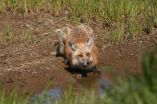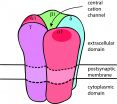This week From AGU: Avalanche detection, paleoclimate reconstructions, India's Tapti Fault
2014-10-07
(Press-News.org) From AGU's blogs: Detecting avalanches from sounds we can't hear http://blogs.agu.org/geospace/2014/10/07/detecting-avalanches-sounds-cant-hear/
Researchers have developed a new avalanche monitoring method that uses sound below the range of human hearing to detect and track these deadly and destructive snow slides. The technique can detect an avalanche from the moment it starts, picking up the unheard thump of a rupture in the snowpack that can precede the snow cascade. It can then track the avalanche's path second by second down the mountain.
In a new study published last month in Geophysical Research Letters, a journal of the American Geophysical Union, scientists report using an array of infrasound detectors on a mountainside to pick up low-frequency sound waves emitted from one of a series of January, 2012, avalanches in Idaho's Canyon Creek corridor.
From this week's Eos: A Community-Driven Framework for Climate Reconstructions http://onlinelibrary.wiley.com/doi/10.1002/eost.v95.40/issuetoc
Scientists involved with the Past Global Changes (PAGES) project have developed goals and recommendations for studying the paleoclimate of the past 2000 years.
From AGU's journals: Tapti Fault in central India: A serious seismic hazard http://onlinelibrary.wiley.com/journal/10.1002/(ISSN)2169-9356/homepage/tapti_fault_in_central_india__a_serious_seismic_hazard.htm
Regions where the continental lithosphere is slowly deforming may be perceived as stable because they are far away from active plate boundaries, but these regions can and do experience large earthquakes. The lithosphere is relatively cool and thick in these areas, so earthquakes can propagate deeper than in more active regions, and have large magnitudes. Because these earthquakes are rare, surrounding populations may not be well prepared and thus face significant hazard, so it's important for these slowly deforming regions to be well characterized.
Copley et al. present new observations of a slowly deforming area in central India, specifically around the Tapti Fault, which is far away from surrounding plate boundaries. To fully understand and characterize the fault, the authors studied alluvial fans that have been offset by fault motion, and the mountain range that has been produced by repeated earthquakes on the fault. Because the authors only found evidence for large Holocene earthquakes on one section of the fault, they note that the remaining unruptured part results in significant seismic hazard in central India.
INFORMATION:
The American Geophysical Union is dedicated to advancing the Earth and space sciences for the benefit of humanity through its scholarly publications, conferences, and outreach programs. AGU is a not-for-profit, professional, scientific organization representing more than 62,000 members in 144 countries. Join our conversation on Facebook, Twitter, YouTube, and other social media channels.
[Attachments] See images for this press release:

ELSE PRESS RELEASES FROM THIS DATE:
2014-10-07
When kids say "the darnedest things," it's often in response to something they heard or saw. This sponge-like learning starts at birth, as infants begin to decipher the social world surrounding them long before they can speak.
Now researchers at the University of Washington have found that children as young as 15 months can detect anger when watching other people's social interactions and then use that emotional information to guide their own behavior.
The study, published in the October/November issue of the journal, Cognitive Development, is the first evidence that ...
2014-10-07
LAWRENCE — Scientists have been laboring to detect cancer and a host of other diseases in people using promising new biomarkers called "exosomes." Indeed, Popular Science magazine named exosome-based cancer diagnostics one of the 20 breakthroughs that will shape the world this year. Exosomes could lead to less invasive, earlier detection of cancer, and sharply boost patients' odds of survival.
"Exosomes are minuscule membrane vesicles — or sacs — released from most, if not all, cell types, including cancer cells," said Yong Zeng, assistant professor ...
2014-10-07
You're obese, at risk for diabetes and cardiovascular disease, and so motivated to improve your diet that you've enrolled in an intensive behavioral program. But if you need to travel more than a short distance to a store that offers a good selection of healthy food, your success may be limited.
A new study from UMass Medical School and the Massachusetts Department of Public Health finds that not having close access to healthy foods can deter even the most motivated dieters from improving their diet, suggesting that easy access to healthy food is as important as personal ...
2014-10-07
Imagine attempting to trace your genetic history using only information from your mother's side. That's what scientists studying the evolution of the red fox had been doing for decades.
Now, University of California, Davis, researchers have for the first time investigated ancestry across the red fox genome, including the Y chromosome, or paternal line. The data, compiled for over 1,000 individuals from all over the world, expose some surprises about the origins, journey and evolution of the red fox, the world's most widely distributed land carnivore.
"The genome and ...
2014-10-07
Typhoon Vongfong strengthened into a Super typhoon on Tuesday, October 7 as NASA's Aqua satellite passed overhead.
On Oct. 7 at 0429 UTC (12:29 a.m. EDT) the Atmospheric Infrared Sounder called AIRS that flies aboard NASA's Aqua satellite captured cloud top temperature data on Super typhoon Vongfong. AIRS data very strong thunderstorms circling Vongfong's clear 27 nautical-mile wide eye. Those cloud top temperatures were colder than -62F/-53C indicating that they were high in the troposphere and capable of generating heavy rainfall. The bands of thunderstorms circling ...
2014-10-07
New Swedish research shows that plasmids containing genes that confer resistance to antibiotics can be enriched by very low concentrations of antibiotics and heavy metals. These results strengthen the suspicion that the antibiotic residues and heavy metals (such as arsenic, silver and copper) that are spread in the environment are contributing to the problems of resistance. These findings have now been published in the highly regarded journal mBio.
Antibiotic resistance is a growing medical problem that threatens human health worldwide. Why and how these resistant bacteria ...
2014-10-07
PHILADELPHIA — Nearly 60,000 Americans suffer from myasthenia gravis (MG), a non-inherited autoimmune form of muscle weakness. The disease has no cure, and the primary treatments are nonspecific immunosuppressants and inhibitors of the enzyme cholinesterase.
Now, a pair of researchers from the Perelman School of Medicine at the University of Pennsylvania have developed a fast-acting "vaccine" that can reverse the course of the disease in rats, and, they hope, in humans. Jon Lindstrom, PhD, a Trustee Professor in the department of Neuroscience led the study, published ...
2014-10-07
A new review of the way health care professionals emphasise weight to define health and wellbeing suggests the approach could be harmful to patients.
Author of the review article, Dr Rachel Calogero of the School of Psychology at the University of Kent, together with experts from other institutions and organisations, recommends that this approach, known as 'weight-normative', is replaced by health care professionals, public health officials and policy-makers with a 'weight-inclusive' approach.
Weight-inclusive approaches, such as the Health At Every Size initiative, ...
2014-10-07
Hamilton, ON (October 7, 2014) – Hospital visitors and staff are greeted with hand sanitizer dispensers in the lobby, by the elevators and outside rooms as reminders to wash their hands to stop infections, but just how clean are patients' hands?
A study led by McMaster University researcher Dr. Jocelyn Srigley has found that hospitalized patients wash their hands infrequently. They wash about 30 per cent of the time while in the washroom, 40 per cent during meal times, and only three per cent of the time when using the kitchens on their units. Hand hygiene rates ...
2014-10-07
LONDON, ON – New research shows probiotic yogurt can reduce the uptake of certain heavy metals and environmental toxins by up to 78% in pregnant women. Led by Scientists at Lawson Health Research Institute's Canadian Centre for Human Microbiome and Probiotic Research, this study provides the first clinical evidence that a probiotic yogurt can be used to reduce the deadly health risks associated with mercury and arsenic.
Environmental toxins like mercury and arsenic are commonly found in drinking water and food products, especially fish. These contaminants are particularly ...
LAST 30 PRESS RELEASES:
[Press-News.org] This week From AGU: Avalanche detection, paleoclimate reconstructions, India's Tapti Fault




